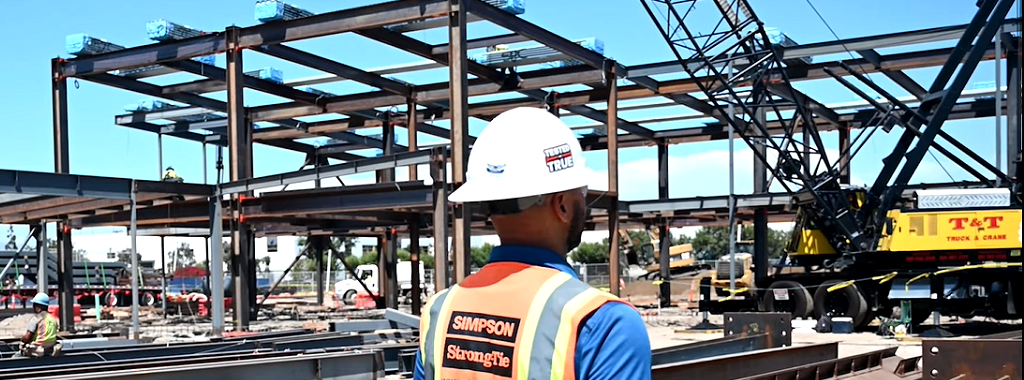Structural engineers for the Rose Avenue Elementary School project in Oxnard, California, a high seismic zone, chose to switch from special moment frames requiring welded connections to the Simpson Strong-Tie Yield-Link moment connection, which features bolted connections instead of onsite welding. This case study shares the experiences of structural engineers, fabricators and other project partners utilizing this innovative solution for structural steel construction.
Tag: structural engineers
Best Practices: The Art of the RFI
Nothing will ruin your day faster than getting a call from a builder reporting an issue with trusses you’ve designed. You hear their frustration as they are faced with a potential delay and additional work to implement a fix. We all desire to eliminate those calls from our daily business, and one way to do so is to work only on jobs with a perfect set of drawings. You know, the drawings with dimensions that are 100% correct, have no errors in the listed wall heights, the heel heights are clearly spelled out with the location of the HVAC equipment and lines identified, and every load path is well thought out.
The truth, though, is that there’s really no such thing as a perfect set of drawings, because there will always be some area needing further clarification to ensure the trusses you design won’t have issues. Although this reality is typically viewed as a source of frustration, it can be an opportunity to provide extra value to your customers by helping them resolve issues before they become a problem in the field. To do this requires a trained eye to identify issues and the use of an RFI (Request for Information) to work through these issues with the appropriate parties involved. In this article, we will walk through some best practices of using an RFI to help eliminate those calls.
Continue Reading
New NCSEA Survey Promoting Stronger Connections Among Structural Engineers
Structural engineers mostly take rightful pride in their skills and the importance of what they do. In other respects, however, job satisfaction can be uneven within the field, without much opportunity for engineers to address questions of professional engagement, mentorship, compensation or equity. The Structural Engineering, Engagement, and Equity (SE3) survey, sponsored by NCSEA, is an attempt to remedy this shortcoming. In the following post, Annie Kao, a structural engineer with Simpson Strong-Tie, gives an overview of this development.
Continue Reading
5 Tips to Stay Informed on Construction News and Industry Updates
For a structural engineer working on multiple projects in various stages of design and construction, it can be challenging to keep up to date on the latest industry trends. However, many of us in the construction industry enjoy learning about new construction techniques and unique projects. Being educated about new technology and design tools can also increase efficiency in the office.Continue Reading
Top Three Reasons Why Structural Engineers Should Attend Webinars
We encourage all our employees to always keep learning and seeking out resources that can stimulate new ideas or help improve processes in their jobs. Webinars are a great way for you to stay engaged in your profession and learn new things about the industry. They mix the convenience of online availability with the interactivity of live seminars, and because some are free or offered at a much lower cost than live trainings, they make it even easier to stay up to date on current issues in your field. Our top three reasons why you should attend structural engineering webinars are below:

Some Webinars Offer Continuing Education Credits
Webinars for structural engineers can be very useful for staying current with professional development requirements. Look to see if the webinar you are interested in attending offers credits. Simpson Strong-Tie offers a wide range of webinars that allow structural engineers to earn CEU and PDH credits. There are plenty of other professional organizations that offer accredited webinars for structural engineers, also. Paul McEntee shares his list of recommended professional resources (including webinars) for structural engineers here.
Learn About Code Changes and Requirements
Staying up to date on code changes and requirements is one of the reasons why continuing education is so important. The Structural Engineers Association of California (SEAOC) has a helpful lunchtime webinar series that delves into 2015 International Building Code (IBC) changes. Simpson Strong-Tie webinars always review current code requirements for the kinds of structural design under discussion. For example, the Best Practices on Prefabricated Wood Shearwall Design webinar covers code reports on shearwall applications.
Learn About the Latest Products and Technology
If you can’t make it to a live training session, using webinars to learn about the most recent products and technology is an effective way to stay current in the field. Whether you want to learn about the latest in prefabricated Strong-Wall® Shearwall panels or to gain fuller understanding of Best Practices for FRP Strengthening Design, webinars can help you design using the most advanced technology.
What was the best webinar you’ve attended? Why was it so good, or what was it you learned? Let us know in the comments below.
Resources and Continuing Education for Structural Engineers
I’ll admit that I’m biased, but structural engineers have the best job in the world. We’re needed to create safe sound structures while factoring in the effects of environmental forces using a combination of physics and experience. It takes a really well rounded individual to do all of that.
In my opinion, the key to being a well rounded professional is to never stop learning or seeking out new resources in your industry. I thought I’d share with you some resources that may be helpful to you as a structural engineer, from my own experience:
Continuing Education Webinars
Attending webinars online is a great way to get Continuing Education credits you need. Webinars enable you to stay sharp on topics that are continually changing and that you may need to adapt to in our industry.
Some of the resources engineers at Simpson Strong-Tie go to for webinars and CECs include:
ACI – American Concrete Institute
AISC – American Institute of Steel Construction
ASCE – American Society of Civil Engineers
AWC – American Wood Council
CFSEI – Cold-Formed Steel Engineers Institute
NCSEA – National Council of Structural Engineers Association
SEAOSC – Structural Engineers Association of Southern California
Engineering Associations

Keeping in touch with fellow structural engineers means that you can talk shop and get some great advice about issues you face on the job. Some associations you can look into:
SEAINT- Structural Engineers Association – International
NCSEA- National Council of Structural Engineers Associations
SEAOC- Structural Engineers Association of California
SEAOSC- Structural Engineers Association of Southern California
SEAOCC- Structural Engineers Association of Central California
SEAOSD- Structural Engineers Association of San Diego
SEAU- Structural Engineers Association of Utah
ASCE- American Society Of Civil Engineers
ACI- American Concrete Institute
AISC- American Institute of Steel Construction
PCA- Portland Cement Association
PCI- Precast/Prestressed Concrete Institute
CRSI- Concrete Reinforcing Steel Institute
AISI- American Iron and Steel Institute
Simpson Strong-Tie also offers great software resources for structural engineers and other building industry professionals. What resources do you recommend? Let us know in the comments below.
How Social Media Can Help Structural Engineers With Their Business
I am pleased to introduce you to one of our newest members of the Simpson Strong-Tie team, Minara El-Rahman. She is our Social Media Manager here at Simpson Strong-Tie. Minara has extensive experience with digital/mobile marketing, social media marketing, engaging with online influencers and blogging. As structural engineers use online resources more and more, she will be contributing to the Structural Engineering blog to help you navigate using them.
The last time we wrote about social media, we gave tips on how structural engineers can use social media to be better at their jobs. But we also believe that you can use social media to grow your business. The more touch points that you can have with your existing and potential clients, the better chance you have at forging a relationship with them. That’s what social media is all about, it is about engaging and fostering a relationship with others: whether it is with an individual, company, brand or your old college buddies.Continue Reading
Social Media Tips for Structural Engineers
In January, our engineer Shane Vilasineekul wrote about his top ten mobile apps. Today we’re talking social media and how it can help you be better at your job. Now I know that the common notion of social media is that it is more of a place to goof off from work, but stay with me here. Think of social media as a place where people can meet. There is a big difference between bars versus a conference for professionals. While they are both places where people can meet in one spot, they perform different functions. Social media is the same way. It can be used for non-professional networking, but it can also be a helpful place where structural engineers can learn about new products, industry news and trends.
Here are ways that structural engineers can use social media:
Use Twitter for Industry Events and Trends: Twitter’s strongest point is its brevity. With a 140-character limit, tweets can really get to the point. Another reason that Twitter is useful is that it is often the social media platform where you see things unfold in real time. For example, you can search industry specific events and see tweets in live time and learn about the demonstrations and seminars your colleagues think are useful, the ones to skip, etc.
LinkedIn Is An Industry News Resource: LinkedIn is not just a place to show off your resume any more. LinkedIn is becoming a hub for industry news. Do you want to know what is going on with other structural engineers? You can join industry specific groups to share tips and ideas. It’s also good practice to follow companies and clients that you work with so you know when they launch a new product, promote a new project or even share their own social media content.
Subscribe to Blogs: Following structural engineering blogs like this one ensures that you never miss a beat about what other industry folks are saying. Subscribing to a blog post means that you can read all the content an industry blog has to offer all from the comfort of your inbox. Blogs also can cover day-of/breaking news that you can’t get from trade publications.
Facebook For Recommendations: While you may look at Facebook as a more family and friends zone, there is something to be said for interacting with fellow structural engineers on this platform. If you are friends with former classmates, you will find a bevy of articles that are helpful for you from an industry standpoint. You can also ask industry specific questions to your friends or ask for recommendations from people you know and trust. Following company pages opens up opportunities to give ideas for new products, learn new product uses, or even find out about new promotions and offers.
YouTube For Educational Videos: An educational video can be a lot more effective and useful than reading a paper. Seeing how a company does product testing may even take the guesswork from your own job. At Simpson Strong-Tie, we make videos for our YouTube channel so you can see our products in action whether it’s a test or even a DIY project.
I hope this blog post takes the guesswork out of social media for you. While these are some starter suggestions, the sky is the limit. What do you use social media for? Do you see professional benefits? Let us know in the comments section.









